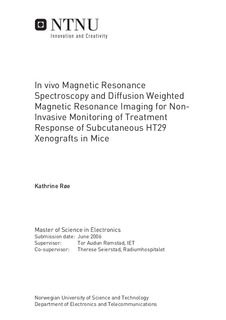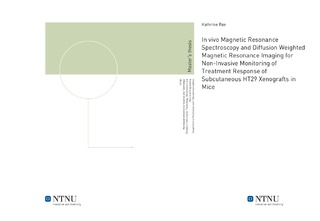| dc.description.abstract | This work investigates whether in vivo magnetic resonance spectroscopy (MRS) and diffusion-weighted magnetic resonance imaging (DW-MRI) can be used for non-invasive monitoring of treatment response in an experimental tumor model. Twenty-nine nude mice with colorectal adenocarcinoma HT29 xenografts on each flank were included into 2 separate experiments. In the first experiment control tumors were compared to tumors irradiated with 15 Gy at Day 2. MR baseline values were established at Day 1 followed by 4 post-treatment MR examinations. Mice were sacrificed for histological response evaluation and high-resolution ex vivo magic angle spinning (HR-MAS) MRS of tumor tissue samples for correlation with in vivo MR data. The second experiment included 3 groups recieving combined chemoradiation therapy; Control group, Capecitabine (359 mg/kg daily Day 1 - Day 5) group and Capecitabine (359 mg/kg daily Day 1 - Day 5) + Oxaliplatin (10 mg/kg at Day 2) group. All left-sided tumors were irradiated with 15 Gy at Day 2. Three repeated MR examinations were compared to the MR baseline values established at Day 1. After MR examinations the mice were sacrificed for histological response evaluation. The choice of chemoterapy was based on a clinical patient study currently running at Rikshospitalet-Radiumhospitalet HF, the LARC-RRP (Locally Advanced Rectal Cancer - Radiation Response Prediction) study. In Experiment 1, localized 1H MR spectra were acquired at short (35 ms) and long (144 ms) echo times (TEs) using a single-voxel technique. The metabolite choline is related to tumor growth. The choline peak area relative to the unsuppressed 35 ms TE water area in the same voxel, i.e. the normalized choline ratio, was assessed in all MRS examinations. For both TEs, the choline ratio increased after irradiation, followed by a decrease and a renewed increase 12 days after irradiation. In Experiment 1, statistically significant differences at the 0.1 level were observed between the choline ratios at Day 5 and Day 12 (p = 0.068) for short TE and between the ratios at Day 3 and Day 8 (p = 0.05) for long TE. The change in choline ratio was in accordance with the tumor necrotic fraction (NF) found in histological analyses. Principal component analysis (PCA) revealed a correlation between the score values of ex vivo HR-MAS MR spectra and necrosis. This suggests a correlation between ex vivo and in vivo MRS. In both experiments, the diffusion in the HT29 xenografts varied during treatment. There was a correlation between the amount of necrosis in tumor and the calculated apparent diffusion coefficient (ADC) obtained from DW-MRI examinations. In Experiment 1, statistically significant differences at the 0.1 level were observed between the ADCs at Day 3 and Day 5 (p = 0.05), between Day 5 and Day 12 (p = 0.068), and between Day 8 and Day 12 (p = 0.068). The HT29 xenografts responded to treatment with an initial increase of necrosis due to the short-term effect of treatment, stimulating development of fibrosis. In accordance to the change in choline and ADC, the level of necrosis increased 8 - 12 days after start of treatment, which might correspond to the long-term effect of treatment. The findings in this work shows that in vivo MRS and DW-MRI can be used for non-invasive monitoring of treatment response in an experimental tumor model. This suggests that in vivo MRS and DW-MRI could yield important information about a tumors response to therapy. | nb_NO |

